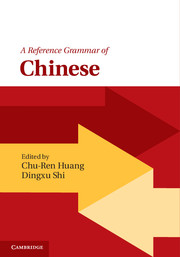Book contents
- Frontmatter
- Dedication
- Contents
- List of figures
- List of tables
- List of contributors
- Preface
- Acknowledgements
- English–Chinese term list
- Chinese–English term list
- 1 Preliminaries
- 2 Syntactic overview
- 3 Lexical word formation
- 4 Verbs and verb phrases
- 5 Aspectual system
- 6 Negation
- 7 Classifiers
- 8 Nouns and nominal phrases
- 9 Relative constructions
- 10 Adjectives and adjective phrases
- 11 Comparison
- 12 Adverbs
- 13 Prepositions and preposition phrases
- 14 Sentence types
- 15 Major non-canonical clause types: ba and bei
- 16 Deixis and anaphora
- 17 Information structure
- Appendix: Punctuation
- Bibliography
- Index
12 - Adverbs
Published online by Cambridge University Press: 05 March 2016
- Frontmatter
- Dedication
- Contents
- List of figures
- List of tables
- List of contributors
- Preface
- Acknowledgements
- English–Chinese term list
- Chinese–English term list
- 1 Preliminaries
- 2 Syntactic overview
- 3 Lexical word formation
- 4 Verbs and verb phrases
- 5 Aspectual system
- 6 Negation
- 7 Classifiers
- 8 Nouns and nominal phrases
- 9 Relative constructions
- 10 Adjectives and adjective phrases
- 11 Comparison
- 12 Adverbs
- 13 Prepositions and preposition phrases
- 14 Sentence types
- 15 Major non-canonical clause types: ba and bei
- 16 Deixis and anaphora
- 17 Information structure
- Appendix: Punctuation
- Bibliography
- Index
Summary
This chapter is concerned with the morphosyntactic and functional properties of adverbs. The major types of adverbs, including temporal adverbs, degree adverbs, scope adverbs, and attitudinal adverbs, will be described. Some of the most commonly used adverbs will also be discussed in detail. An adverb typically modifies the properties of a verb, an adjective, or another adverb. Non-derived adverbs are not morphologically marked, while derived adverbs undergo a word-formation process, such as reduplication or de-suffixation. It is also important to notice that many phrasal units can have the same modifying functions and they are called adverbials. In this chapter, we will only focus on the non-derived adverbs.
Distinctive properties of adverbs
• Adverbs are typically monosyllabic or disyllabic. A significant number of disyllabic adverbs are formed by the reduplication of monosyllabic adjectives or adverbs.
• Adverbs are typically positioned to the left of the main predicate of a clause and to the left of the unit it modifies. Some adverbs can occur at the sentence-initial position, but others can never do so. When there is more than one adverb in a clause, their occurrence is ordered.
• Adverbs in Chinese can be largely classified into two groups. Descriptive adverbs typically have content word characteristics, including having a big number of members in this group and being open to neologism. Functional adverbs typically have functional word characteristics, including being a small closed group with versatile high-frequency grammatical features.
Overview of adverbs
Similar to many other languages, adverbs in Chinese form a loosely defined category in which members can differ from one another in their morphology, syntax, meaning, and function.
Chinese adverbs can first and foremost be divided into two groups: descriptive adverbs and functional adverbs (also called “restrictive” adverbs). Descriptive adverbs have a specific meaning that describes a particular aspect of an action or a state, such as the manner or means of carrying out an action (e.g., 高声 gao1sheng1 ‘loudly,’ 亲自 qin1zi4 ‘in person’). Compared to functional adverbs, descriptive adverbs are more lexical, more of the “content” or “open-class” word type, and the majority of them are disyllabic or longer. Functional adverbs, on the other hand, are more of the “function” or “closed-class” word type.
- Type
- Chapter
- Information
- A Reference Grammar of Chinese , pp. 315 - 352Publisher: Cambridge University PressPrint publication year: 2016
- 2
- Cited by

